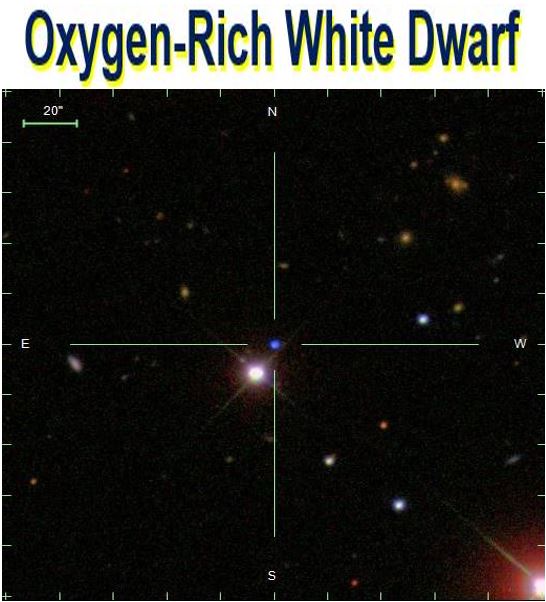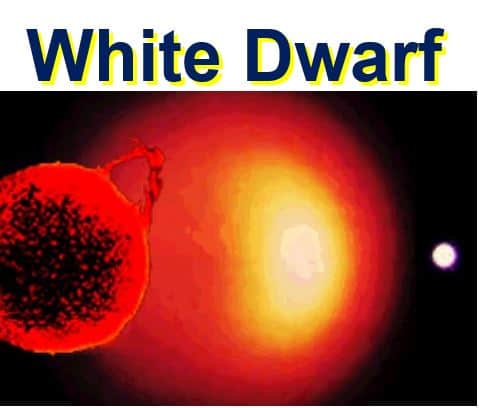Astrophysicists have discovered an oxygen-rich white dwarf star, something nobody has ever seen before, even though its existence had been theorized.
The discovery could challenge the textbook wisdom of single stellar (star) evolution, and provide a crucial link to some types of supernovae discovered over the past ten years.
White dwarf stars are what stars like our Sun become after all their nuclear fuel has been exhausted. Close to the end of its nuclear burning stage, this type of star expels most of its outer material, creating a planetary nebula, with only the hot core of the star remaining.
 Image from the Sloan Digital Sky Survey of the blue oxygen atmosphere white dwarf SDSS J124043.01+671034.68. (Image: Wikipedia)
Image from the Sloan Digital Sky Survey of the blue oxygen atmosphere white dwarf SDSS J124043.01+671034.68. (Image: Wikipedia)
They are less than ten times the mass of our Sun, which in the world of stars is relatively small – however, they are extremely dense.
The intense gravity that exists under such density causes the lighter elements, such as helium or hydrogen, to rise to the surface of the star, smothering and masking the heavier elements below.
How did it end up like this?
While gathering and analyzing data from the SDSS (Sloan Digital Sky Survey), Gustavo Ourique and Souza Oliveira Kepler, from the Universidade Federal do Rio Grande do Sul in Brazil, and Detlev Koester, from Kiel University in Germany, wrote in the journal Science (citation below) that they identified SDSS J124043.01+671034.68, a white dwarf with all its outer layer of light elements stripped away, revealing an almost pure layer of oxygen.
A number of theories have predicted that a white dwarf’s outer layer could be stripped. This is the first evidence confirming this phenomenon.
 An artist’s conception of the evolution of our Sun (left) through the red giant stage (centre) and onto a white dwarf (right). (Image: imagine.gsfc.nasa.gov)
An artist’s conception of the evolution of our Sun (left) through the red giant stage (centre) and onto a white dwarf (right). (Image: imagine.gsfc.nasa.gov)
It is possible that interactions with a nearby companion in a binary star caused J124043.01+671034.68 to reveal its oxygen envelope.
Scientists suggest that perhaps a massive pulse of burning carbon from the star’s centre, emulating outwards, eliminated all the lighter elements.
In an Abstract in the journal, the authors wrote:
“The fact that no hydrogen or helium are observed is surprising. Oxygen, neon, and magnesium are the products of carbon burning, which occurs in stars at the high-mass end of pre–white dwarf formation.”
“This star, a possible oxygen-neon white dwarf, will provide a rare observational test of the evolutionary paths toward white dwarfs.”
Perspective in same journal
In a Perspective (separate article) also in Science (citation below), Boris Gänsicke, from the Department of Physics at the University of Warwick in England, explains that most stars in our Universe are in the process of burning hydrogen into helium via nuclear fusion deep down within their cores.
This process powers their luminosity and provides the thermal pressure that prevents them from collapsing under their own weight.
When the nuclear fuel runs out stars end their lives. At this point they either explode in a supernova, or shed most of their mass and leave behind a white dwarf. The second possibility is more common.
Regarding the article by Kepler et al, Gänsicke wrote:
“Kepler et al. (1) announce the identification of a white dwarf called SDSSJ1240+6710 that has an almost pure oxygen atmosphere, diluted only by traces of neon, magnesium, and silicon.”
“This white dwarf challenges the textbook wisdom of single stellar evolution and may provide a link to some of the types of supernovae discovered over the past decade.”
Citations:
1. “A white dwarf with an oxygen atmosphere,” S. O. Kepler, Detlev Koester and Gustavo Ourique. Science, Vol. 352, Issue 6281, pp. 67-69. 1 April 2016. DOI: 10.1126/science.aad6705.
2. “An odd one out,” Boris Gänsicke. Science, Vol. 352, Issue 6281, pp. 37. 1 April 2016. DOI: 10.1126/science.aaf3768.

